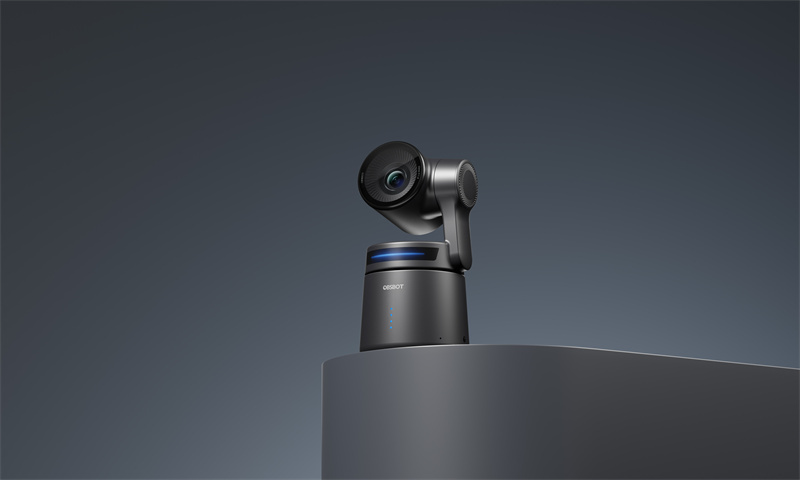What is NDI Camera: The Complete Guide

NDI (Network Device Interface) cameras are a game-changer in the world of live streaming. They empower creators to amplify their content with high-quality video, minimal latency, and cost-effective setups. From studio to outdoor shoots, an NDI PTZ camera revolutionizes live streaming with its new, flexible, and budget-friendly solution.
Read on to learn more about NDI Camera and unlock a new era of live-streaming excellence in the following sections.
Part 1: What is NDI?
NDI stands for Network Device Interface. It is a protocol developed by NewTek that allows video and audio data to be transmitted over IP networks. NDI enables seamless integration of cameras, computers, and other devices into a network, simplifying video production and live streaming processes.
With NDI, content creators can easily transmit high-quality video and audio signals over existing network infrastructures without the need for specialized hardware or complicated setups. This technology has revolutionized the way media professionals capture, produce, and distribute content, offering flexibility, scalability, and cost-effectiveness in various industries such as broadcasting, esports, education, and more.
Part 2: What is an NDI Camera?
An NDI camera is designed to seamlessly integrate into existing network setups for live streaming and video production purposes. Unlike traditional cameras, an NDI camera uses the NDI protocol to transmit audio and video data through a single Ethernet cable. These cameras connect to the Local Area Network (LAN) and seamlessly interact with various software applications using NDI technology.
This allows content creators to stream high-quality video with minimal latency and without the need for additional hardware or complex setups. NDI cameras are known for their flexibility, cost-effectiveness, and ease of use, making them a popular choice for professionals and enthusiasts in the live-streaming industry.
Types of NDI Camera
1. NDI Camera
It features minimal latency when sending high-quality videos through an IP connection. It demands a minimum bandwidth of 125mbps for effective data transmission, which a standard 1-Gbps Ethernet cable can accommodate.
2. NDI HX Camera
In contrast, the NDI HX camera efficiently delivers high-quality videos even under limited bandwidth conditions. This camera needs a dedicated bandwidth of 4 to 24mbps for seamless streaming. Like its counterpart, a Standard 1-Gbps Ethernet cable is suitable for transmitting metadata effectively.
NDI cameras include two prominent types, each tailored to specific bandwidth needs, offering creators versatile solutions for producing and transmitting top-notch live content.
Part 3: How Can NDI Cameras Benefit Live Streaming
In old times, connecting a camera to a live production switcher required many different cables. Each cable had a specific job: sending video, controlling the camera, sending audio, and combining everything. These cables only sent signals in one direction.
But now, there's NDI. You don't need to do any unique setup. Even though it is more than six years old, it can arrange and manage multiple cameras for the visual dynamics of your live stream without complexity.
Advantages of Using NDI Cameras in Live Streaming
1. Effortless High-Quality Video
With NDI 4K, you can transmit top-notch video over standard Ethernet networks. There is no need for costly, bulky, dedicated video cables—your existing network infrastructure does the job seamlessly.
2. Swift and Seamless
NDI ensures low-latency video transmission, often under one millisecond. This near-instant transfer is perfect for scenarios where precise video synchronization is paramount.
3. Simplicity and Integration
Integrating NDI into your current setup is a breeze. Link multiple video devices like cameras, switchers, and monitors without intricate and expensive hardware, streamlining your workflow.
4. Adaptability and Scalability
NDI camera scales easily on standard Ethernet networks and expands for larger, complex setups. Ideal for vast events like concerts and conferences.
5. Versatile and Dynamic
NDI broadcast accommodates various video formats and resolutions, making it flexible for different applications. Adapt it to diverse environments, from live events to broadcasting studios.
6. Cost-Effective Solution
Sidestep the need for specialized cabling and elaborate setups. NDI's integration with existing networks offers a cost-effective alternative without compromising quality.
7. Real-Time Interaction
NDI allows real-time communication and immediate interactions between streamers and their audience through comments, chats, and Q&A sessions.
So, with an NDI PTZ camera, improve your live streaming capabilities, and enjoy exceptional quality, real-time engagement, and seamless integration.
Part 4: The Best NDI Camera You Should Know
Now, let me introduce you to the best and cheapest NDI camera. Yes. I am talking about the newly launched OBSBOT Tail Air Streaming Camera. Watch as AI technology effortlessly tracks humans, pets, and objects, ensuring you capture every vibrant moment of your daily activities. The OBSBOT Tail Air's advanced camera system, expertly crafted optics, and meticulously designed lens configuration guarantee exceptional 4K streaming performance.
Key Features:
- NDI HX3 Support: Achieve high-quality, low-latency live streaming via Wi-Fi, Ethernet, or USB-C/micro HDMI/Power over Ethernet (PoE) cables.
- AI Director Grids: Divide your video into different grids and select anyone to broadcast for more precision and quality of your live stream.
- Real-time Mobile Device Video Signal: Wirelessly view and control your OBSBOT Tail Air's video signal on your mobile device for stunning shots from multiple angles.
- Low-Light Performance: Experience superior low-light video quality, reduced noise, and exceptional image performance with the enhanced true 2μm large pixel size and ƒ1.8 aperture.
- Intuitive Gesture Control: Control your OBSBOT Tail Air with intuitive gestures, like dynamic zoom adjustments, for seamless and accurate video shooting.
So, expand your viewer base with the OBSBOT Tail Air – where AI-driven tracking, remarkable optics, and quick connectivity combine for an exceptional live streaming experience.
Part 5: How do I Connect My Camera to NDI?
Are you ready to understand the power of NDI for seamless camera connectivity? Follow these simple steps to connect your camera to NDI and elevate your live streaming experience:
Step 1: Determine Camera Compatibility
Ensure that your camera is NDI-compatible, or use an external device such as an NDI converter to convert the camera's video output into NDI.
Step 2: Choose an NDI Software
Install NDI-compatible software on your computer, such as NewTek NDI Tools or OBS Studio, to receive and work with NDI streams.
Step 3: Connect Camera to NDI Device
Connect your camera to the NDI device (if using an external converter) using the appropriate video output connection, such as HDMI or SDI.
Step 4: Configure NDI Settings
Set up the NDI device to convert your camera's video feed into an NDI stream. Configure the settings according to your camera's specifications and network requirements.
Step 5: Connect to Network
Ensure that your camera and NDI device are connected to the same network as the computer running the NDI software to enable communication and streaming.
Step 6: Receive NDI Stream
Open the NDI software on your computer and locate the NDI stream coming from your camera. You should now be able to view and work with the camera feed within the software.
Congratulations, you've successfully connected your camera to NDI, opening up a world of possibilities for your live-streaming bids. Whether it's crisp video quality, reduced latency, or simplified setups, NDI has transformed how cameras connect and communicate.
Sample Video For How To Built Wireless NDI Solution With OBSBOT Tail Air
Part 6: What is the Difference between NDI and SDI?
SDI, Serial Digital Interface, is a cable system that transmits uncompressed video across long distances. NDI represents a newer technology of advanced video compression techniques for high-quality video transmission and reception over standard computer networks.
Key Differences Between NDI and SDI
1. Transmission Method
- NDI is a video-over-IP protocol that transmits video, audio, and data over standard Ethernet networks. It allows for flexible and scalable video production workflows using network infrastructure.
- SDI, on the other hand, is a digital video interface standard that transmits uncompressed video and audio signals over coaxial cables. It is known for its reliability, low latency, and high-quality signal transmission.
2. Connectivity
- NDI relies on network connectivity, allowing devices to communicate and transmit video streams over standard Ethernet networks.
- SDI requires physical cabling between devices, making it suitable for point-to-point connections between cameras, switchers, and displays.
3. Flexibility
- NDI offers flexibility in video production workflows by enabling easy sharing and distribution of video content over a network. It is suitable for live production, streaming, and remote collaboration.
- SDI is more rigid in its setup, requiring direct physical connections between devices. It is commonly used in professional broadcast environments where reliability and quality are paramount.
4. Scalability
- NDI is highly scalable and can support multiple video streams over a single network, making it suitable for multi-camera productions and large-scale video distribution.
- SDI connections are typically point-to-point, which can limit scalability in complex production setups that require multiple video sources and destinations.
Part 7: What is Better NDl or SDI?
NDI is ideal for network-based video production workflows that prioritize flexibility and scalability, while SDI is favored for its reliability and high-quality signal transmission in traditional broadcast environments. The choice between NDI and SDI depends on factors such as your production requirements, existing infrastructure, budget, and preference for wired or network-based solutions. In some cases, a hybrid approach that combines both NDI and SDI technologies may be the most suitable option for achieving the desired results.
Part 8: Does NDI need a router?
Yes, NDI does not necessarily need a router to function. NDI operates on existing Ethernet networks, allowing for easy integration into your network infrastructure. NDI uses standard network protocols to transmit video, audio, and data over IP, making it possible to send and receive NDI streams within a local area network (LAN) without the need for a dedicated router. However, for larger or more complex network setups, using a router can help manage network traffic and ensure optimal performance when transmitting NDI streams across different devices.
Conclusion
PTZ camera with NDI provides high-quality video output and offers streamlined control via a single ethernet connection. Their integration with NDI tools simplifies video productions and more engaging content creation. In short, NDI empowers multiple cameras as the future of video communication today.

















